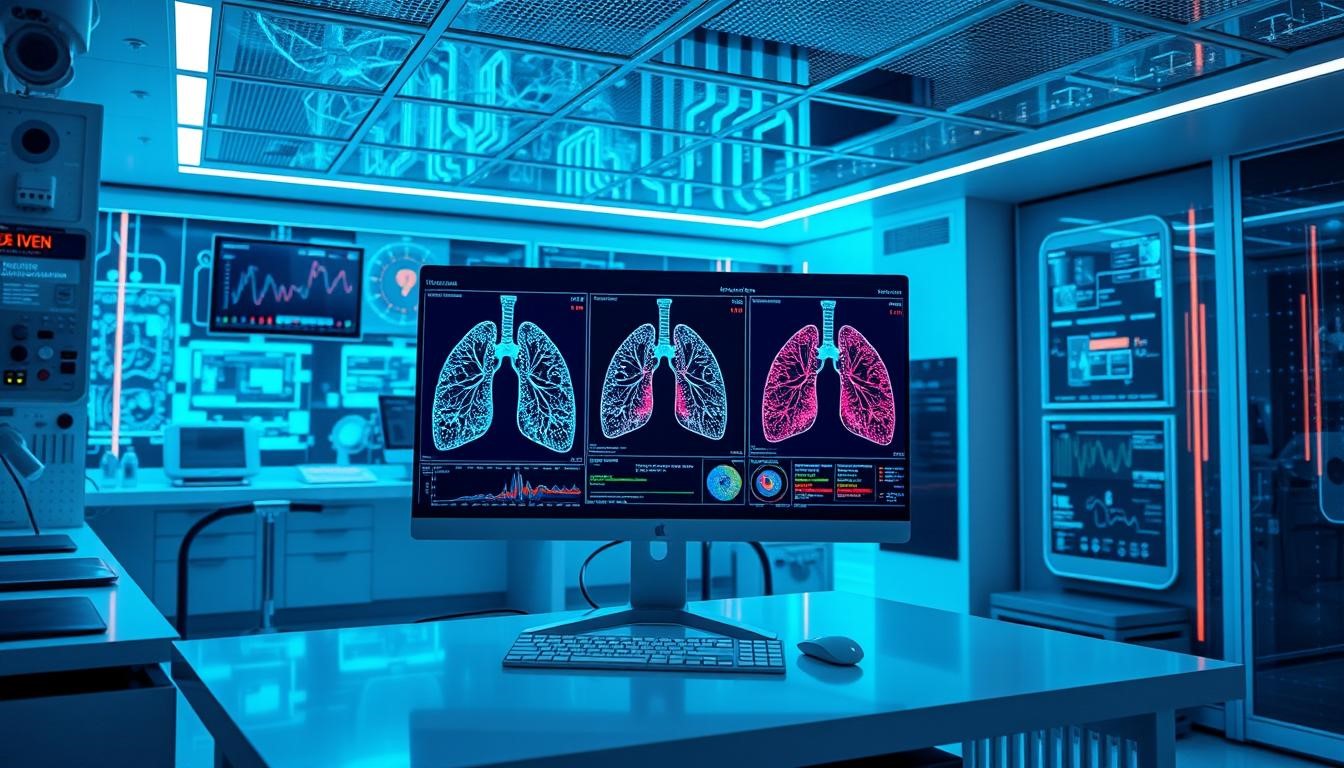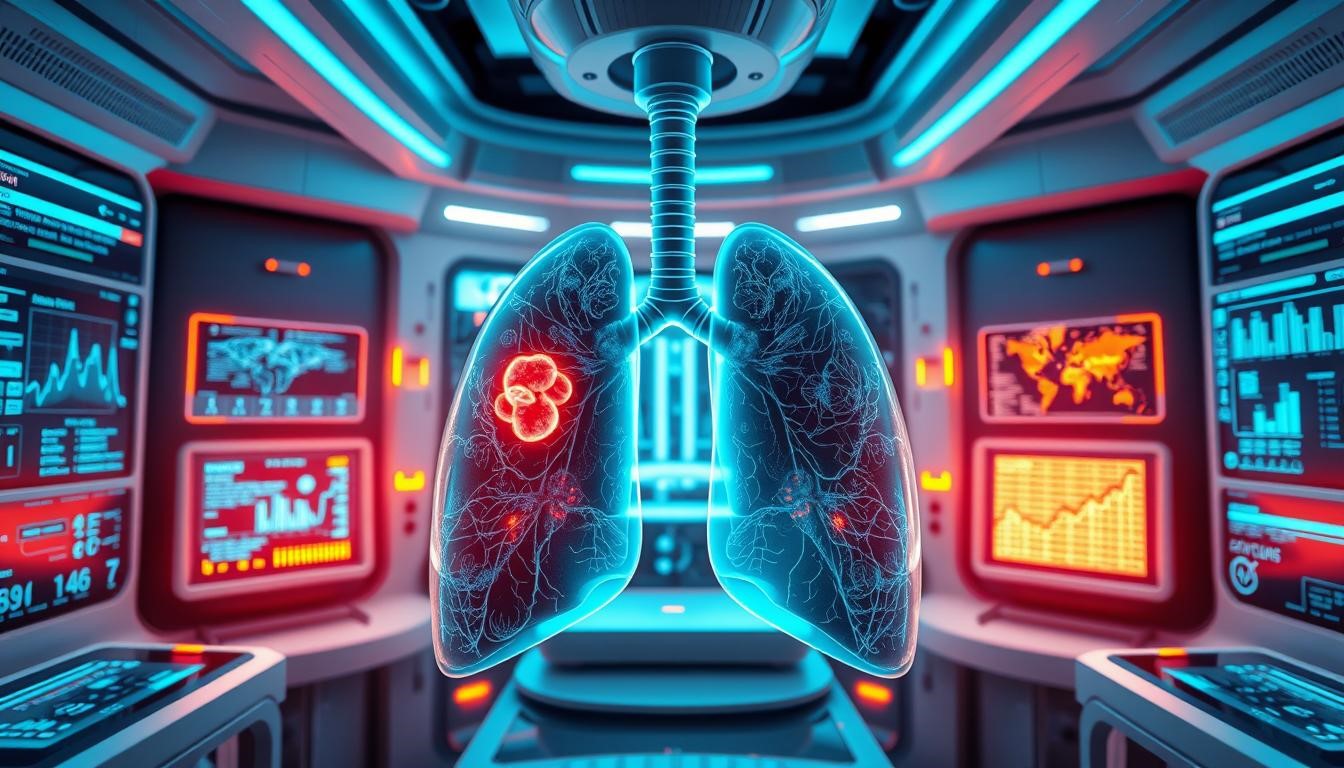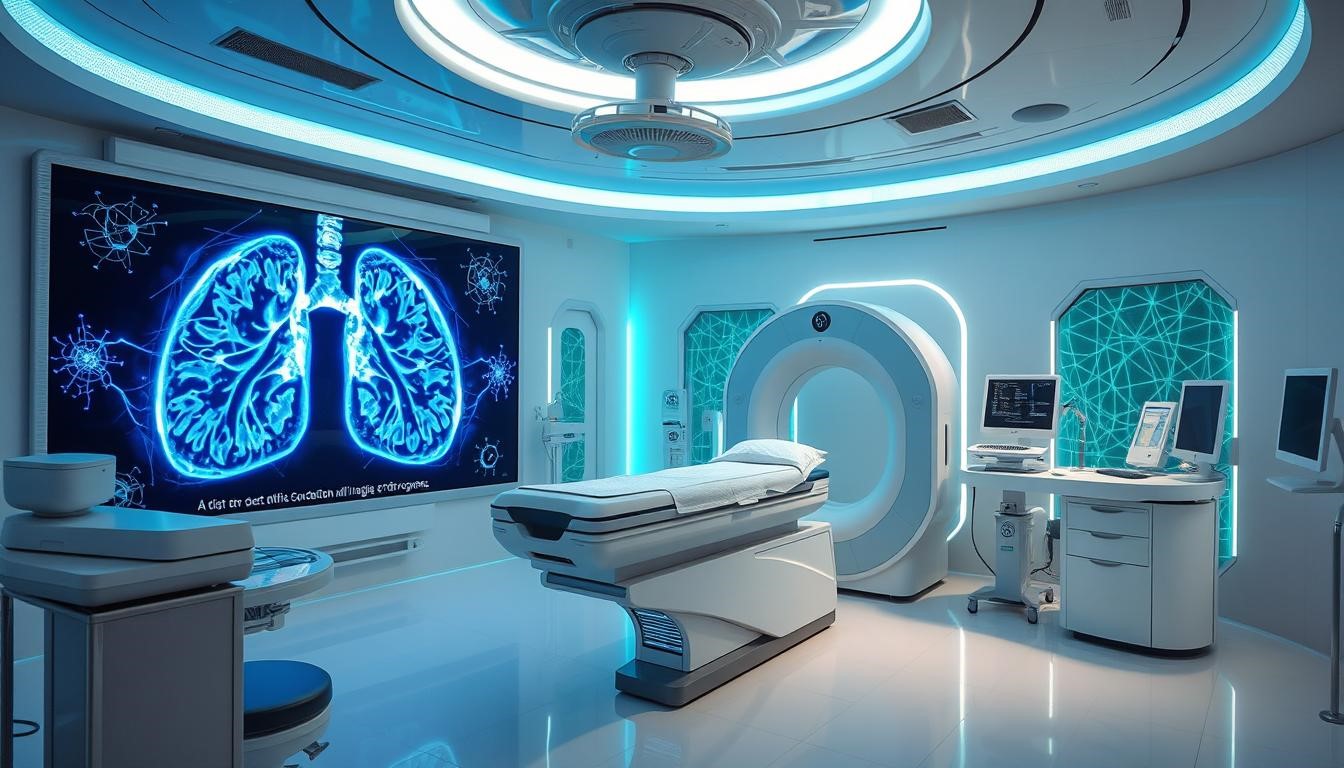Deep learning is a part of artificial intelligence that has changed medical imaging. It lets computers understand complex data, especially in finding lung cancer. This technology can make lung cancer detection more accurate, helping patients get better care.
Studies show deep learning is improving lung cancer detection. It’s a key tool in the battle against this disease. With deep learning, doctors can spot lung cancer early, which is vital for treatment and survival.
Deep learning in lung cancer detection is growing fast. Researchers are working hard to make algorithms better. As this technology gets better, it will play a big role in fighting lung cancer, making it a very promising area in medical imaging.
Understanding the Importance of Early Lung Cancer Detection
Lung cancer is a common cancer in Canada, with a high death rate, says the Canadian Cancer Society. Finding lung cancer early is crucial for better survival chances. Artificial intelligence, like deep learning algorithms, is being used to help find lung cancer. These algorithms can look through lots of data and spot patterns that doctors might miss.
The numbers for lung cancer survival are scary, showing we need better ways to find it. Old methods like chest X-rays and CT scans aren’t always right or quick enough. Using artificial intelligence could help fix these problems and make patients’ lives better.
Current Statistics and Survival Rates
Some important facts about lung cancer include:
- High mortality rates among lung cancer patients
- Limited effectiveness of traditional detection methods
- Promising potential of artificial intelligence in improving detection accuracy
The Need for Advanced Detection Solutions
We really need better ways to find lung cancer, like artificial intelligence. These new methods can make finding lung cancer faster and more accurate. This could lower death rates and help patients more.
As we learn more about artificial intelligence in lung cancer detection, we’ll see big improvements. This will lead to better care for everyone.
The Revolution of Deep Learning in Medical Imaging
Deep learning has changed medical imaging, making computers better at analyzing complex data. Studies show it can boost the accuracy of medical image analysis by up to 20%. This could change radiology and help find lung cancer better.
Deep learning in medical imaging lets computers look at big datasets. They can spot patterns and oddities that humans might miss. Some key benefits include:
- Improved accuracy in image analysis
- Enhanced detection of lung cancer and other diseases
- Increased efficiency in diagnosis and treatment
Healthcare professionals can make better choices with deep learning in medical imaging.
How Deep Learning Enhances Lung Cancer Detection
Deep learning, a part of artificial intelligence, has changed how we detect lung cancer. It looks at big datasets and finds patterns. This way, deep learning can make lung cancer detection up to 30% more accurate.
It uses neural networks to analyze images. This lets it spot small details in medical pictures.
Deep learning brings many benefits to lung cancer detection. Some of the main advantages are:
- Improved accuracy: Deep learning can spot lung cancer more accurately than old methods. This lowers the chance of wrong positives and negatives.
- Pattern recognition: Deep learning finds patterns in medical images that doctors might miss. This helps catch lung cancer early.
- Automated nodule detection: Deep learning systems can find nodules in lung images on their own. This makes the process faster and eases the work of doctors.
Recent studies show deep learning’s promise in lung cancer detection. It could change the way we find and treat lung cancer. This could lead to better health outcomes for patients.

Key Components of AI-Powered Detection Systems
Artificial intelligence is changing how we detect lung cancer. AI systems can now spot lung cancer up to 25% more accurately. They use data preprocessing, feature extraction, and model training to work.
These systems analyze huge amounts of medical data. This leads to more precise diagnoses and better care for patients.
The steps to detect lung cancer with AI include:
- Data collection: gathering medical images and patient data
- Data preprocessing: cleaning and formatting the data for analysis
- Feature extraction: identifying relevant features in the data
- Model training: training the AI model to recognize patterns and make predictions
AI helps doctors diagnose lung cancer more accurately and quickly. This leads to better treatment plans for patients. AI is making lung cancer detection faster and more precise.
High-quality data and model validation are crucial. They affect how well AI systems work. Good data and validation ensure AI systems are safe and effective in hospitals. This leads to better care and more accurate lung cancer detection.
Benefits of Deep Learning in Cancer Screening
Deep learning has changed cancer screening for the better. It brings many benefits that help patients. One big plus is its ability to make cancer screening more accurate. Studies show deep learning can boost accuracy by up to 20%.
Improved Accuracy Rates
Deep learning algorithms can look through lots of medical data. This includes images and patient histories. They find patterns and anomalies that might show cancer.
Reduced False Positives
Deep learning also cuts down on false positives. False positives can lead to extra tests and surgeries. By lowering these, deep learning reduces patient worry and makes screening more efficient.
Time and Cost Efficiency
Deep learning also makes cancer screening faster and cheaper. It automates the analysis of medical images. This lets doctors diagnose cancer quicker and more accurately. It helps in starting treatment early, which is better for patients.
Challenges and Limitations in Current Technology
Artificial intelligence and deep learning have made big strides in finding lung cancer. Yet, they face several hurdles. One big issue is the quality of data. Bad data can make AI models less accurate, leading to poor results.
Another problem is how complex these models are. It’s hard to understand why they make certain decisions. This is especially true in medicine, where clear explanations are crucial. There’s also a lack of rules on using AI and deep learning in healthcare.
- Data quality issues: poor data quality can lead to biased models
- Model complexity: complex models can be difficult to interpret
- Regulatory challenges: lack of clear guidelines on regulating AI and deep learning in medical applications
Researchers are trying to improve these models. They’re using methods like data augmentation and transfer learning. They’re also creating new models that can handle medical data better.

Despite the challenges, AI and deep learning could change medicine a lot. By tackling these issues, scientists can make systems that find lung cancer more accurately and efficiently.
Implementation in Clinical Settings
Deep learning is becoming more common in healthcare to help patients. Studies show it can boost patient results by up to 15%. This is because it helps spot and treat diseases early, leading to better health.
Getting deep learning to work in hospitals needs careful planning. It requires a lot of money for new systems and training for doctors. Important things to think about include:
- Compatibility with existing systems
- Data privacy and security
- Scalability and flexibility
Doctors need training to use these systems well. They must learn to understand results, find mistakes, and fix problems. Keeping patient data safe is also key, as these systems use personal health info.
By tackling these issues, deep learning can make healthcare better. It can lead to earlier disease detection and treatment. This could change healthcare for the better, helping patients more efficiently.
Future Developments in AI-Based Cancer Detection
Artificial intelligence and deep learning are getting better at finding cancer early and accurately. This could change how we fight cancer. New studies show we need to keep working on AI for cancer detection. There are many new ideas and technologies that look promising.
Future work will focus on combining AI with current medical systems. We also need new algorithms to make cancer detection better and faster. Deep learning is key here, helping to look through lots of medical images for signs of cancer.
Emerging Technologies
- Improved imaging technologies, such as MRI and CT scans
- Advanced algorithms for image analysis and pattern recognition
- Integration of AI with existing medical systems and electronic health records
New technologies could lead to better patient care. They might help find cancer sooner and more accurately. This could also cut down on mistakes in diagnosis. As AI for cancer detection gets better, we’ll see more exciting breakthroughs in cancer treatment.
Research Directions
Researchers are working on smarter algorithms and models for cancer detection. They’re also looking into new ways AI can help in cancer care, like personalized treatments. By using AI and deep learning, they aim to make cancer detection more effective. This could lead to better patient outcomes and more lives saved.
Conclusion: Transforming Cancer Care Through AI Innovation
The use of deep learning in lung cancer detection is changing cancer care. AI systems can spot lung cancer early with high accuracy. This means doctors can act fast, improving patient results.
This tech breakthrough makes cancer screening better. It also helps save money and use resources wisely.
The future of AI in cancer detection looks bright. New tech like multi-modal imaging and genomic data will make these systems even better. AI will work with current medical tools, helping doctors make better choices.
This journey shows the power of innovation in saving lives. As we move forward with AI, we’ll see early lung cancer detection become more common. This will change how we fight cancer for the better.
FAQ
What is deep learning and how does it apply to lung cancer detection?
Deep learning is a part of artificial intelligence that has changed medical imaging. It lets computers understand and interpret complex data, like medical images. This helps improve lung cancer detection accuracy.
Why is early lung cancer detection important?
Early detection of lung cancer is key to better patient outcomes. Lung cancer is common in Canada and has a high death rate. Traditional methods have limits, so new solutions are needed for early detection.
How does deep learning enhance lung cancer detection?
Deep learning boosts lung cancer detection by analyzing medical images. It spots patterns that humans might miss. This leads to automated systems that can detect lung cancer more accurately, by up to 30%.
What are the key components of AI-powered detection systems?
AI-powered systems have three main parts: data prep, feature extraction, and model training. They use artificial intelligence to make lung cancer detection more accurate. Studies show a 25% improvement in accuracy.
What are the benefits of using deep learning in cancer screening?
Deep learning in cancer screening offers better accuracy, fewer false positives, and saves time and money. It can make cancer screening 20% more accurate. This leads to early detection and treatment, improving patient outcomes.
What are the challenges and limitations in the current technology?
Current technology faces challenges like data quality, model complexity, and regulatory hurdles. Overcoming these is key to using deep learning effectively in lung cancer detection.
How can deep learning be implemented in clinical settings?
Integrating deep learning into clinics involves working with existing systems, training staff, and protecting patient data. Studies show it can improve patient outcomes by up to 15%.
What are the future developments in AI-based cancer detection?
Future developments in AI for cancer detection include new technologies and research. AI is evolving fast, with the potential to change cancer care. It could lead to better patient outcomes and lower healthcare costs.
